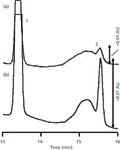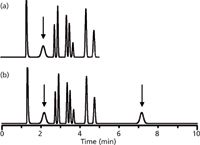Extra Chromatographic Peaks — A Case Study
What do you do when an unexpected peak appears in the chromatogram?
A common liquid chromatography (LC) problem that I get e-mails about from readers of this column relates to unexpected and unwanted peaks that appear in the chromatogram. This month's discussion centres around an e-mail discussion I had with a reader of the electronic version of LCGC (available on-line in countries where the paper editions are not available) about a problem they were experiencing. Because this problem relates to a pharmaceutical product and contains proprietary information, I've exercised some obfuscation privileges to hide some of the specifics, but retain the key information.
The problem relates to the analysis of an antibiotic for impurities. It is a fairly simple method, comprising a phosphate–acetonitrile gradient on a reversed-phase column. The method had been validated and worked quite well to determine a mixture of eight antibiotics and impurities. After successful use in the development laboratory, it was transferred to another laboratory for routine analysis. For identification, I'll refer to these as the R&D laboratory and the production laboratory.
Extra Peak
When the method was transferred to the production laboratory, it appeared to work well, with one exception — a broad peak appeared at a retention time that overlapped the elution of antibiotic 2. In Figure 1, I've shown a section of the baseline including peaks for antibiotics 1 (13.4 min) and 2 (15.6 min) from a chromatogram obtained in the R&D laboratory. This was a typical result for the injection of these two compounds. When the same sample was run in the production laboratory, the results of Figure 2(a) were observed. The peak for antibiotic 1 appears as normal, but there is a broad peak that all but obscures antibiotic 2.

Figure 1
An extra peak, that is not related to the sample itself, in a gradient run typically arises from one of three sources:
- late elution from a previous chromatogram
- carryover from a previous injection
- contamination of the mobile phase (ghost peaks).
Many people call all three kinds of peaks ghost peaks, but I like to distinguish between them because, although they may look similar in the chromatogram, their sources are different, and so the process of eliminating them will be different. Let's look briefly at my definitions of each of these peak types.
Late elution of a peak from a previous chromatogram results when you don't allow enough time for all the peaks to be eluted following sample injection. As a result, the problem peak continues to travel through the column, but shows up in a later chromatogram, instead of the one in which it belongs.
Carryover from a previous injection is caused by sample that is actually injected, but its injection is unintentional. For example, you make an injection and get a normal run, then you make a blank injection with no analyte present, but the peak appears anyway, usually much smaller than the original.
Ghost peaks tend to be unique to gradient elution, whereas late elution and carryover are common for isocratic separations, as well. Ghost peaks appear when a contaminant is present in the mobile phase (usually the weak, A-solvent), is concentrated on the column and then is released as the gradient runs. Ghost peaks will appear in sample injections when a blank is injected, and even when a gradient is run with no injection at all.
Do Your Homework
Troubleshooting can be a timeconsuming process and unless you have a well-thought-out plan, a lot of time can be wasted and the problem source may be difficult to isolate. I like to make a list of the most probable causes, in this case the potential differences that exist between the two laboratories. Here are the most likely possibilities:
- mobile phases (both A and B)
- column
- instrument
- how the method is run.
I'm basically lazy, so I usually apply my "easy vs. powerful" rule of thumb at this point. That is, I'll often do an easy check first, even if it isn't as likely to isolate the problem as a more difficult one. Another practice that I take advantage of is module substitution — replacing a suspect part with a known good one. One of the ways we do this almost instinctively is to make up a new batch of mobile phase or replace the column. Both of these changes were made in the production laboratory, one at a time, which is a good idea if you aren't sure of the problem source. Neither a fresh batch of mobile phase nor a new column solved the problem.
My contact in the R&D laboratory developed the method on one brand of high performance liquid chromatography (HPLC) equipment, but the production laboratory was using another brand. Part of the question about instrument differences was answered easily when the R&D laboratory transferred their mobile phase and column to the second brand of equipment in the R&D laboratory — it worked just fine. This indicated that there wasn't an inherent instrument design difference that was causing the problem, although other problems, such as contamination, could exist.
Now that the easy things are out of the way, it is time to roll up our sleeves and figure out where the problem lies. Let's look at each of the three peak sources mentioned above and work through them.
Carryover
Carryover has something to do with the equipment, usually the autosampler and not the column. A carryover peak is an actual sample peak, not something left on the column from a prior injection. Usually carryover is associated with insufficient flushing of the autosampler between injections, and generates a much smaller peak than normal. For example, after the injection of one sample, an injection of a blank is made and a peak appears at the same retention time as the sample peak, but much smaller. Another blank injection will usually be proportionally smaller than the second injection. Because carryover under normal circumstances is <0.1%, it is very rare to see the same peak appear after two blank injections (0.1% × 0.1% = 0.01%, probably too small to see). Sometimes a sample component can be adsorbed on surfaces of the autosampler tubing or injection valve and will bleed off slowly, resulting in carryover peaks that decline in size only slowly with successive injections, but this is not common for most samples.
Once again, we can do some mental work, rather than physical, and eliminate this source of the current problem. The peak we observe has an area that has a different retention time, is much larger than our sample peak and is much broader [note the peak width of the problem peak at 15.2 min compared to the analyte peak at 15.6 min in Figure 2(b)]. If the problem was carryover, the presence of the carryover peak should make the normal analyte peak larger but should not change its area or retention time. So we can eliminate carryover from the probable causes.

Figure 2
If carryover was the problem, it usually can be corrected by one or both of two fixes. First, use a more thorough autosampler wash routine. Use the strong solvent of the mobile phase (acetonitrile in the present case) as the autosampler wash solvent and increase the number of wash cycles or wash volume between injections. If this does not solve the problem, look for poorly swept passages in the plumbing that might act as tiny reservoirs to trap sample that would then mix with the next injection. Check to be sure that all the tube fittings are seated properly. This is more common when PEEK (polyetherether-ketone) fittings are used to make connections. If the system over-pressures, the tubing can slip in these connections, but not enough to come completely loose, leaving a small gap at the tip of the tubing that can trap a small amount of sample. If the injection valve is worn, sometimes it will be less well-flushed and carryover can occur. This is fairly rare, because injector valves are made to cycle 100–500000 times before a rebuild is necessary. However, if you have >50000 injections on the valve and have eliminated other potential problem sources, replacement of the injector rotor might be a good idea.
Late Elution
Late eluted peaks are usually easy to isolate. As a general rule, whether the separation is isocratic or gradient, all the peaks in a given region of the chromatogram should be about the same peak width. If a peak appears that is much wider than its neighbours, the first thing I suspect is that it comes from a previous injection. An example of this is shown for the simulated chromatograms of Figure 3. In Figure 3(a), the peak just after 2 min (arrow) is much wider than the neighbouring peaks, so it is suspected as a lateeluted peak from a previous injection. In Figure 3(b) the run time is extended, and now there are two broad peaks, the early one from the previous run and the one at 7 min where it belongs for that injection.

Figure 3
Late-eluted peaks are typically sample-related — that is, they are sample components that don't have enough time to come off the column. Because the broad peaks were never seen in the R&D laboratory, and the same sample was being analysed, it is not likely that the problem source is late elution. However, if the problem was isolated to this cause, there are two simple fixes. First, you could extend the run time to allow the peak to be eluted normally. This would work for the example of Figure 3, but would double the run time, which may not be desirable. Another alternative, especially if the problem peak is not of interest, is to flush it off the column with a strong solvent. When a gradient is used, as in the present problem, the column is flushed easily by extending the gradient to 95–100% of the B-solvent (acetonitrile in this case). To speed the process, this can be done as a step. For example, if the normal gradient ran 5–70% B in 20 min, it could be followed by a 70–100% step, a 5-min hold to flush strongly retained material from the column, then a step back to 5% to re-equilibrate for the next injection.
Ghost Peaks
When gradients are run, any organic material that does not pass through the column under the starting conditions will build up at the head of the column and will be eluted later in the gradient. This is because at the starting conditions (5% acetonitrile in the present case), most organic compounds will have nearly infinite retention, so they just collect on the column as the mobile phase passes through. This is an easy problem to diagnose. Just perform the following sequence of runs. I'll assume for the moment that the normal equilibration between runs is 10 min.
1. Equilibrate normally (10 min)
2. Run a blank gradient (no injection)
3. Equilibrate 10 min
4. Blank gradient
5. Equilibrate 30 min
6. Blank gradient
After you've run this sequence, examine the chromatograms. Ignore the first gradient, because it rarely is equilibrated exactly the same as a normal run. Look at the size of the ghost peaks in the second run (10-min equilibration) and compare this to the same peaks in the third run (30-min equilibration). If the peaks in run 3 grow in the same proportion as the ratio of equilibration times between run 2 and run 3 (three-fold in the present example), the source is probably the A-solvent. This is because the longer equilibration allowed three times as much junk to collect before it was eluted from the column.
When the A-solvent is the problem, each of the components should be checked separately by eliminating them in a stepwise fashion. For example, just use water for A instead of phosphate buffer. If the problem disappears, the phosphate is the probable cause, if not, it is the water. If the chromatogram is better without buffer, try a new bottle of phosphate. Some other possible sources of A-solvent contamination include dirty glassware, the pH meter and contaminated water. Several of these are discussed in detail in chapter 17 of reference 1.
If the above tests seem to confirm the problem source, but careful elimination of mobile-phase components did not solve the problem, another, less common source is left: system contamination. Usually the HPLC system is exposed only to highpurity solvents and reagents, but contamination can occur if you don't practise good laboratory habits. This can be a particular problem when acetate or phosphate buffer are used, because they are good energy sources for microbial growth. If the mobilephase reservoirs are not replaced with clean ones on a regular basis or if the system is left unattended with buffers standing in the tubing, contamination can occur when bacteria grow in the aqueous phase. Normally, replacement of the reservoir with each new batch of mobile phase and flushing with nonbuffered water or solvent at the end of each day's work are sufficient to keep the system clean. But if you don't regularly practise these preventive measures, any component that contacts the mobile phase can become contaminated, including the reservoir, inlet frits, tubing, degasser, pump and autosampler. If you've eliminated the obvious causes, an aggressive cleaning may be in order.
Here's the recommended procedure for aggressive system flushing:
1. Remove the column and replace it with a piece of tubing routed to waste.
2. Make a batch (for example, 0.5 L) of ≈30% phosphoric acid (just dilute concentrated phosphoric acid — 1 part of acid + 2 parts water) and place in a clean reservoir.
3. Flush all buffers and organic solvents from the system with HPLC-grade water.
4. Place all inlet lines in the 30% acid reservoir and pump 25–50 mL of acid through each solvent inlet line. Flush the autosampler in both the load and inject positions. Use the same solution and perform multiple injector needle and seal washes.
5. Remove the acid reservoir and briefly rinse the inlet tube ends and frits with HPLC-grade water.
6. Fill a fresh reservoir with HPLCgrade water and flush all lines, needle and seal washes, and any other passages exposed to the acid flush. A 25–50 mL water flush should be sufficient, but you can check the pH of the waste line to be sure it is no longer acidic. If the pH is still too low, replace the water and continue to flush.
This acid-washing procedure was implemented in the production laboratory and a significant improvement was observed, as is seen in Figure 2. In Figure 2(b), the relative size of the contaminant peak to antibiotic 2 is greatly diminished (note that for the chromatograms of Figures 1 and 2, the same concentration of standard was used, so the peak height for antibiotic 2 should be the same in all cases; the scale is noted in each chromatogram). It does look like system contamination was at least part of the problem.
What's Next?
So, where do we go from here? We've eliminated several possible causes of the unwanted peak and reduced the peak size, but we haven't eliminated it completely. We've discovered that the system was contaminated and cleaned it. I still don't know the results from the stepwise isolation of mobilephase components (I would have done that series of experiments before acid-washing the hardware), and I suspect that this may be the source of the remaining problems. Because of the presence of contamination in the system, I suspect that there may be other problems caused by contaminants in the laboratory. Specifically, I suspect that the water is the problem source, but that is just a gut-level hypothesis. I would replace the water with water that is known to be pure, such as purchased HPLC-grade water or HPLC-grade water obtained from the R&D laboratory's water source. I don't know how physically close the two laboratories are to each other. If they are in close proximity, I would take known good mobile phases and a good column from R&D to the production laboratory and substitute each separately, and at that point the remaining source of the problem should be obvious.
It would be nice if all these case studies were wrapped up neatly with cause and effect, but the truth is that often when good progress is being made on fixing the problem, I don't hear any more about it. In spite of that, I think the present case study gives us a good context for discussion of how to distinguish between the various sources of extra peaks and how to isolate the source so it can be eliminated.
John W. Dolan is vice president of LC Resources, Walnut Creek, California, USA. He is also a member of LCGC Europe's editorial advisory board. Direct correspondence about this column should go to "LC Troubleshooting", LCGC Europe, 4A Bridgegate Pavilion, Chester Business Park, Wrexham Road, Chester, CH4 9QH, UK, or email the editor, Alasdair Matheson, at amatheson@advanstar.com
Reference
(1) L.R. Snyder, J.J. Kirkland, and J.W. Dolan, Introduction to Modern Liquid Chromatography, 3rd ed. (Wiley, Hoboken, New Jersey, 2010).
Study Explores Thin-Film Extraction of Biogenic Amines via HPLC-MS/MS
March 27th 2025Scientists from Tabriz University and the University of Tabriz explored cellulose acetate-UiO-66-COOH as an affordable coating sorbent for thin film extraction of biogenic amines from cheese and alcohol-free beverages using HPLC-MS/MS.
New Study Investigates Optimizing Extra-Column Band Broadening in Micro-flow Capillary LC
March 12th 2025Shimadzu Corporation and Vrije Universiteit Brussel researchers recently investigated how extra-column band broadening (ECBB) can be optimized in micro-flow capillary liquid chromatography.








